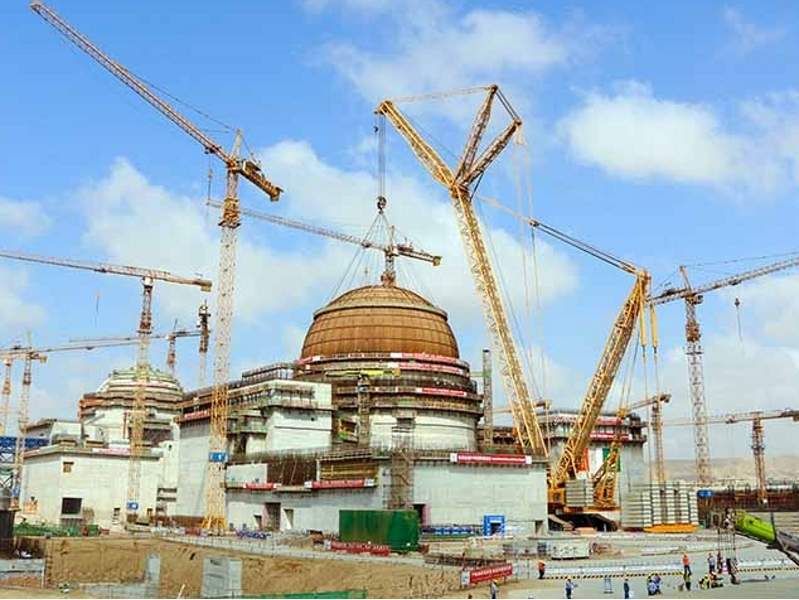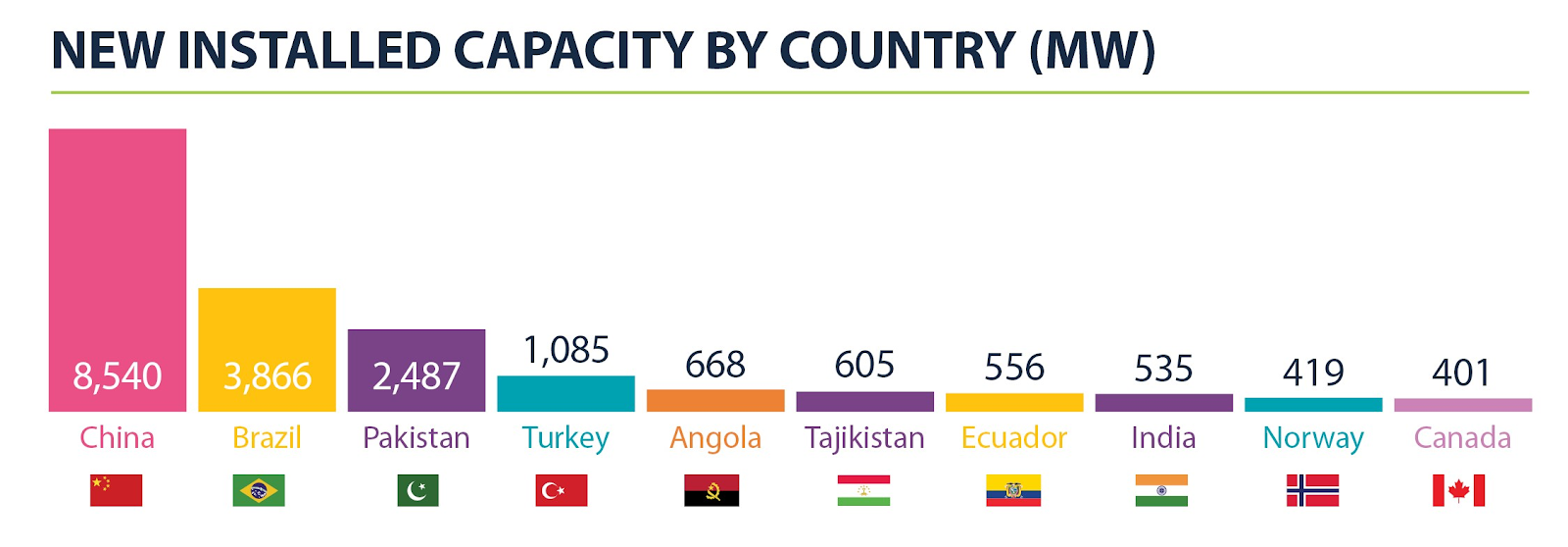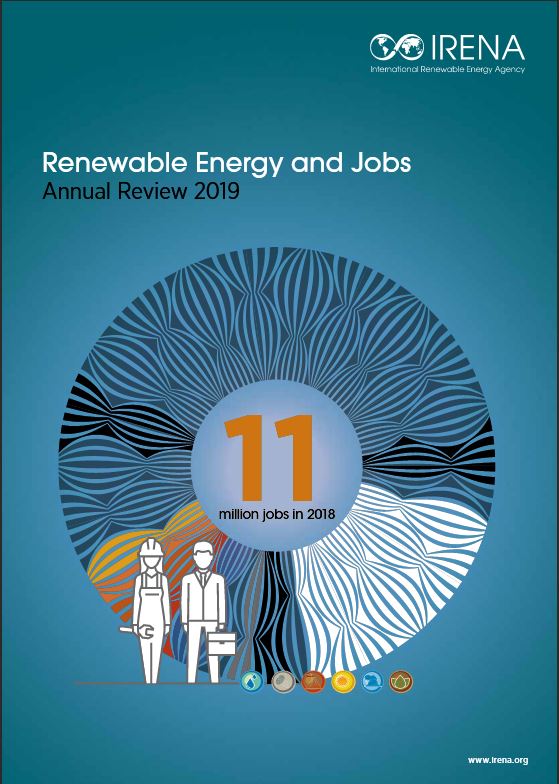http://www.riazhaq.com/2019/07/pakistan-ramps-up-nuclear-power-to.html
Construction of 1,100 MW nuclear power reactor K2 unit in Karachi has been completed by China National Nuclear Corporation, according to media reports. A similar reactor unit K3 will add another 1,100 MW of nuclear power to the grid, bringing the total nuclear power installed capacity of Pakistan to 3,630 MW (12% of total power) by 2022. Hualong One reactors being installed in Pakistan are based on improved Westinghouse AP1000 design which is far safer than Chernobyl and Fukushima plants. In addition, Pakistan is also generating 9,389 MW (about 28% of total power) of low-carbon hydroelectric power in response to rising concerns about climate change.
Karachi Nuclear Power Plant (KANUPP):
With the placement of the outer containment shell, K2 is now ready for containment and heat tests. It is scheduled to begin operations in 2020. It’s built using the Chinese HPR1000 technology, which features a dual containment design, with the outer containment providing additional protection for the primary containment.
KANUPP is Pakistan's first nuclear power plant where construction started in 1966 in Karachi. The plant was connected to the national grid on 18 October 1972. KANUPP, a pressurized heavy water reactor of 137 MW gross capacity was constructed by Canadian General Electric under a turnkey contract. In 1976, vendor support for spare parts and fuel was withdrawn. The PAEC undertook the task of indigenously manufacturing the required spare parts and nuclear fuel on an emergency basis and, since 1980, KANUPP has successfully operated using fuel manufactured by the PAEC, according to International Atomic Energy Agency (IAEA). Here is an except of IAEA's 2018 report on nuclear power in Pakistan:
"Despite the keen interest of Pakistan in building additional nuclear plants, it took more than two decades before the second nuclear power plant started construction. This delay was due to Pakistan’s lack of access to international nuclear technology coupled with a lack of indigenous industrial infrastructure. The construction of Pakistan’s second nuclear plant, C-1, a pressurized water reactor (PWR), was made possible in 1993 with the help of the China National Nuclear Corporation (CNNC). The plant was connected to the national grid on 13 June 2000 and has a gross capacity of 325 MW. A third nuclear power plant, C-2, with 325 MW gross capacity started commercial operation on 18 May 2011. The fourth unit, C-3, started commercial operation on 6 December 2016. It has a gross capacity of 340 MW and a similar plant, C-4, sited beside C-3, was connected to the grid on 25 June 2017. The first concrete pours to mark the start of construction of Karachi Coastal Power Project, a project containing two nuclear units, K-2 and K-3 (1100 MW each), based on an improved PWR design, were 20 August 2015 and 31 May 2016, respectively."
International Energy Agency:
International Energy Agency (IEA) has recently warned that "steep decline in nuclear power would threaten energy security and climate goals". "With nuclear power facing an uncertain future in many countries, the world risks a steep decline in its use in advanced economies that could result in billions of tonnes of additional carbon emissions", the IEA has said.
Nuclear is the second-largest low-carbon power source in the world today, accounting for 10% of global electricity generation. It is second only to hydropower at 16%, according to International Energy Agency (IEA). Pakistan nuclear plants are expected to generate 3,630 MW (12% of total power vs 10% global average) by 2022. Pakistan is also generating 9,389 MW (about 28% of total power vs 16% global average) of low-carbon hydroelectric power in response to rising concerns about climate change.
Nuclear Plant Safety Concerns:
Activists in Pakistan have raised serious concerns about potential risks from K2 and K3 plants to the population in Karachi. Are such concerns valid?
The worst nuclear disaster in the history of nuclear power generation was at Chernobyl in present day Ukraine. One of the key reasons was that the Chernobyl plant did not have the fortified containment structure common to most nuclear power plants elsewhere in the world. KANUPP K-2 and K-3 reactors have two containment shells: primary and secondary. It is noteworthy that Bhopal Union Carbide disaster was history's worst industrial disaster, far bigger in terms of human toll than the Chernobyl disaster.
China signed a technology transfer deal with the United States in 2006 that put the Westinghouse AP1000 reactor design at the “core” of its atomic energy program. It also resolved to use advanced third-generation technology in its safety review after the 2011 Fukushima nuclear plant disaster.
Unlike Fukushima where underground emergency cooling system failed due to flooding, the AP1000 design stores water above the reactor that can be gravity-fed to keep it cool if the pumps fail. The EPR reactors employ multiple redundant generators and cooling systems to lower meltdown risk.
Hydropower Generation:
The biggest and most important source of low-carbon energy in Pakistan is its hydroelectric power plants. Pakistan ranked third in the world by adding nearly 2,500 MW of hydropower in 2018, according to Hydropower Status Report 2019. China added the most capacity with the installation of 8,540 megawatts, followed by Brazil (3,866 MW), Pakistan (2,487 MW), Turkey (1,085 MW), Angola (668 MW), Tajikistan (605 MW), Ecuador (556 MW), India (535 MW), Norway (419 MW) and Canada (401 MW).
Pakistan's Water and Power Development Authority (WAPDA) says commissioning of the 108-MW Golen Gol 2, 1,410-MW Tarbela 4th Extension and 969-MW Neelum Jhelum hydropower projects in 2018 boosted its hydroelectric generating capacity of 9,389 MW, an increase of 36% in just one year, according to Hydro Review. Hydropower now makes up about 28% of the total installed capacity of 33,836 MW as of February, 2019. WAPDA reports contributing 25.63 billion units of hydroelectricity to the national grid during the year, “despite the fact that water flows in 2018 remained historically low.” This contribution “greatly helped the country in meeting electricity needs and lowering the electricity tariff for the consumers.”
Pakistan has the potential to generate 59,000 MW of hydropower, according to studies conducted by the nation's Water and Power Development Authority (WAPDA). Currently, it's generating only 9,389 MW of hydroelectric power, about 16% of the estimated potential. Media reports indicate that China is prepared to finance and build another 40,000MW capacity as part of the development of the Northern Indus Cascade region which begins in Skardu in Gilgit-Baltistan and runs through to Tarbela, the site of Pakistan’s biggest dam, in Khyber-Pakhtunkhwa province.
Pakistan has made only a small contribution to climate change through carbon emissions. And yet, it counts among the dozen or so nations considered most vulnerable to its damaging effects. These include rising temperatures, recurring cycles of floods and droughts and resulting disruption in food production.
Summary:
Construction of 1,100 MW nuclear power reactor K2 unit in Karachi has been completed by China National Nuclear Corporation, according to media reports. A similar reactor unit K3 will add another 1,100 MW of nuclear power to the grid, bringing the total nuclear power installed capacity of Pakistan to 3,630 MW (12% of total power) by 2022. Hualong One reactors being installed in Pakistan are based on improved Westinghouse AP1000 design which is far safer than Chernobyl and Fukushima plants. In addition, Pakistan is also generating 9,389 MW (about 28% of total power) of low-carbon hydroelectric power in response to rising concerns about climate change. One of the ways Pakistan can help reduce carbon emissions is by realizing its full nuclear and hydroelectric power potential by building more nuclear plants and dams. The development of the Northern Indus Cascade region to generate 40,000MW of hydropower is a significant part of this effort.
http://www.riazhaq.com/2019/07/pakistan-ramps-up-nuclear-power-to.html
Construction of 1,100 MW nuclear power reactor K2 unit in Karachi has been completed by China National Nuclear Corporation, according to media reports. A similar reactor unit K3 will add another 1,100 MW of nuclear power to the grid, bringing the total nuclear power installed capacity of Pakistan to 3,630 MW (12% of total power) by 2022. Hualong One reactors being installed in Pakistan are based on improved Westinghouse AP1000 design which is far safer than Chernobyl and Fukushima plants. In addition, Pakistan is also generating 9,389 MW (about 28% of total power) of low-carbon hydroelectric power in response to rising concerns about climate change.
Karachi Nuclear Power Plant (KANUPP):
With the placement of the outer containment shell, K2 is now ready for containment and heat tests. It is scheduled to begin operations in 2020. It’s built using the Chinese HPR1000 technology, which features a dual containment design, with the outer containment providing additional protection for the primary containment.

|
| Karachi Nuclear Power Plant K2 Unit Under Construction. Source: CNNC |
KANUPP is Pakistan's first nuclear power plant where construction started in 1966 in Karachi. The plant was connected to the national grid on 18 October 1972. KANUPP, a pressurized heavy water reactor of 137 MW gross capacity was constructed by Canadian General Electric under a turnkey contract. In 1976, vendor support for spare parts and fuel was withdrawn. The PAEC undertook the task of indigenously manufacturing the required spare parts and nuclear fuel on an emergency basis and, since 1980, KANUPP has successfully operated using fuel manufactured by the PAEC, according to International Atomic Energy Agency (IAEA). Here is an except of IAEA's 2018 report on nuclear power in Pakistan:
"Despite the keen interest of Pakistan in building additional nuclear plants, it took more than two decades before the second nuclear power plant started construction. This delay was due to Pakistan’s lack of access to international nuclear technology coupled with a lack of indigenous industrial infrastructure. The construction of Pakistan’s second nuclear plant, C-1, a pressurized water reactor (PWR), was made possible in 1993 with the help of the China National Nuclear Corporation (CNNC). The plant was connected to the national grid on 13 June 2000 and has a gross capacity of 325 MW. A third nuclear power plant, C-2, with 325 MW gross capacity started commercial operation on 18 May 2011. The fourth unit, C-3, started commercial operation on 6 December 2016. It has a gross capacity of 340 MW and a similar plant, C-4, sited beside C-3, was connected to the grid on 25 June 2017. The first concrete pours to mark the start of construction of Karachi Coastal Power Project, a project containing two nuclear units, K-2 and K-3 (1100 MW each), based on an improved PWR design, were 20 August 2015 and 31 May 2016, respectively."
International Energy Agency:
International Energy Agency (IEA) has recently warned that "steep decline in nuclear power would threaten energy security and climate goals". "With nuclear power facing an uncertain future in many countries, the world risks a steep decline in its use in advanced economies that could result in billions of tonnes of additional carbon emissions", the IEA has said.
Nuclear is the second-largest low-carbon power source in the world today, accounting for 10% of global electricity generation. It is second only to hydropower at 16%, according to International Energy Agency (IEA). Pakistan nuclear plants are expected to generate 3,630 MW (12% of total power vs 10% global average) by 2022. Pakistan is also generating 9,389 MW (about 28% of total power vs 16% global average) of low-carbon hydroelectric power in response to rising concerns about climate change.
Nuclear Plant Safety Concerns:
Activists in Pakistan have raised serious concerns about potential risks from K2 and K3 plants to the population in Karachi. Are such concerns valid?
The worst nuclear disaster in the history of nuclear power generation was at Chernobyl in present day Ukraine. One of the key reasons was that the Chernobyl plant did not have the fortified containment structure common to most nuclear power plants elsewhere in the world. KANUPP K-2 and K-3 reactors have two containment shells: primary and secondary. It is noteworthy that Bhopal Union Carbide disaster was history's worst industrial disaster, far bigger in terms of human toll than the Chernobyl disaster.
China signed a technology transfer deal with the United States in 2006 that put the Westinghouse AP1000 reactor design at the “core” of its atomic energy program. It also resolved to use advanced third-generation technology in its safety review after the 2011 Fukushima nuclear plant disaster.
Unlike Fukushima where underground emergency cooling system failed due to flooding, the AP1000 design stores water above the reactor that can be gravity-fed to keep it cool if the pumps fail. The EPR reactors employ multiple redundant generators and cooling systems to lower meltdown risk.
Hydropower Generation:
The biggest and most important source of low-carbon energy in Pakistan is its hydroelectric power plants. Pakistan ranked third in the world by adding nearly 2,500 MW of hydropower in 2018, according to Hydropower Status Report 2019. China added the most capacity with the installation of 8,540 megawatts, followed by Brazil (3,866 MW), Pakistan (2,487 MW), Turkey (1,085 MW), Angola (668 MW), Tajikistan (605 MW), Ecuador (556 MW), India (535 MW), Norway (419 MW) and Canada (401 MW).
Pakistan's Water and Power Development Authority (WAPDA) says commissioning of the 108-MW Golen Gol 2, 1,410-MW Tarbela 4th Extension and 969-MW Neelum Jhelum hydropower projects in 2018 boosted its hydroelectric generating capacity of 9,389 MW, an increase of 36% in just one year, according to Hydro Review. Hydropower now makes up about 28% of the total installed capacity of 33,836 MW as of February, 2019. WAPDA reports contributing 25.63 billion units of hydroelectricity to the national grid during the year, “despite the fact that water flows in 2018 remained historically low.” This contribution “greatly helped the country in meeting electricity needs and lowering the electricity tariff for the consumers.”
Pakistan has the potential to generate 59,000 MW of hydropower, according to studies conducted by the nation's Water and Power Development Authority (WAPDA). Currently, it's generating only 9,389 MW of hydroelectric power, about 16% of the estimated potential. Media reports indicate that China is prepared to finance and build another 40,000MW capacity as part of the development of the Northern Indus Cascade region which begins in Skardu in Gilgit-Baltistan and runs through to Tarbela, the site of Pakistan’s biggest dam, in Khyber-Pakhtunkhwa province.
Pakistan has made only a small contribution to climate change through carbon emissions. And yet, it counts among the dozen or so nations considered most vulnerable to its damaging effects. These include rising temperatures, recurring cycles of floods and droughts and resulting disruption in food production.
Summary:
Construction of 1,100 MW nuclear power reactor K2 unit in Karachi has been completed by China National Nuclear Corporation, according to media reports. A similar reactor unit K3 will add another 1,100 MW of nuclear power to the grid, bringing the total nuclear power installed capacity of Pakistan to 3,630 MW (12% of total power) by 2022. Hualong One reactors being installed in Pakistan are based on improved Westinghouse AP1000 design which is far safer than Chernobyl and Fukushima plants. In addition, Pakistan is also generating 9,389 MW (about 28% of total power) of low-carbon hydroelectric power in response to rising concerns about climate change. One of the ways Pakistan can help reduce carbon emissions is by realizing its full nuclear and hydroelectric power potential by building more nuclear plants and dams. The development of the Northern Indus Cascade region to generate 40,000MW of hydropower is a significant part of this effort.
http://www.riazhaq.com/2019/07/pakistan-ramps-up-nuclear-power-to.html






































